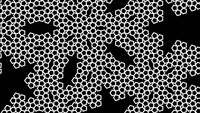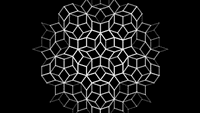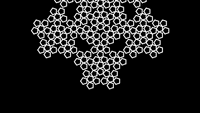Examples+
Koch Curve
by Daniel Shiffman
Renders a simple fractal, the Koch snowflake. Each recursive level is drawn in sequence.
Highlighted Features
/**
* Koch Curve
* by Daniel Shiffman.
*
* Renders a simple fractal, the Koch snowflake.
* Each recursive level is drawn in sequence.
*/
KochFractal k;
void setup() {
size(640, 360);
frameRate(1); // Animate slowly
k = new KochFractal();
}
void draw() {
background(0);
// Draws the snowflake!
k.render();
// Iterate
k.nextLevel();
// Let's not do it more than 5 times. . .
if (k.getCount() > 5) {
k.restart();
}
}
// The Nature of Code
// Daniel Shiffman
// http://natureofcode.com
// Koch Curve
// A class to describe one line segment in the fractal
// Includes methods to calculate midPVectors along the line according to the Koch algorithm
class KochLine {
// Two PVectors,
// a is the "left" PVector and
// b is the "right PVector
PVector a;
PVector b;
KochLine(PVector start, PVector end) {
a = start.copy();
b = end.copy();
}
void display() {
stroke(255);
line(a.x, a.y, b.x, b.y);
}
PVector start() {
return a.copy();
}
PVector end() {
return b.copy();
}
// This is easy, just 1/3 of the way
PVector kochleft() {
PVector v = PVector.sub(b, a);
v.div(3);
v.add(a);
return v;
}
// More complicated, have to use a little trig to figure out where this PVector is!
PVector kochmiddle() {
PVector v = PVector.sub(b, a);
v.div(3);
PVector p = a.copy();
p.add(v);
v.rotate(-radians(60));
p.add(v);
return p;
}
// Easy, just 2/3 of the way
PVector kochright() {
PVector v = PVector.sub(a, b);
v.div(3);
v.add(b);
return v;
}
}
// Koch Curve
// A class to manage the list of line segments in the snowflake pattern
class KochFractal {
PVector start; // A PVector for the start
PVector end; // A PVector for the end
ArrayList<KochLine> lines; // A list to keep track of all the lines
int count;
KochFractal() {
start = new PVector(0,height-20);
end = new PVector(width,height-20);
lines = new ArrayList<KochLine>();
restart();
}
void nextLevel() {
// For every line that is in the arraylist
// create 4 more lines in a new arraylist
lines = iterate(lines);
count++;
}
void restart() {
count = 0; // Reset count
lines.clear(); // Empty the array list
lines.add(new KochLine(start,end)); // Add the initial line (from one end PVector to the other)
}
int getCount() {
return count;
}
// This is easy, just draw all the lines
void render() {
for(KochLine l : lines) {
l.display();
}
}
// This is where the **MAGIC** happens
// Step 1: Create an empty arraylist
// Step 2: For every line currently in the arraylist
// - calculate 4 line segments based on Koch algorithm
// - add all 4 line segments into the new arraylist
// Step 3: Return the new arraylist and it becomes the list of line segments for the structure
// As we do this over and over again, each line gets broken into 4 lines, which gets broken into 4 lines, and so on. . .
ArrayList iterate(ArrayList<KochLine> before) {
ArrayList now = new ArrayList<KochLine>(); // Create emtpy list
for(KochLine l : before) {
// Calculate 5 koch PVectors (done for us by the line object)
PVector a = l.start();
PVector b = l.kochleft();
PVector c = l.kochmiddle();
PVector d = l.kochright();
PVector e = l.end();
// Make line segments between all the PVectors and add them
now.add(new KochLine(a,b));
now.add(new KochLine(b,c));
now.add(new KochLine(c,d));
now.add(new KochLine(d,e));
}
return now;
}
}
Related Examples
This example is for Processing 4+. If you have a previous version, use the examples included with your software. If you see any errors or have suggestions, please let us know.




